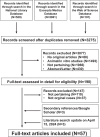Transient secondary pseudo-hypoaldosteronism in infants with urinary tract infections: systematic literature review
- PMID: 38985174
- PMCID: PMC11413108
- DOI: 10.1007/s00431-024-05676-3
Transient secondary pseudo-hypoaldosteronism in infants with urinary tract infections: systematic literature review
Abstract
Infants with a congenital anomaly of the kidney and urinary tract sometimes present with hyponatremia, hyperkalemia, and metabolic acidosis due to under-responsiveness to aldosterone, hereafter referred to as secondary pseudo-hypoaldosteronism. The purpose of this report is to investigate pseudo-hypoaldosteronism in infant urinary tract infection. A systematic review was conducted following PRISMA guidelines after PROSPERO (CRD42022364210) registration. The National Library of Medicine, Excerpta Medica, Web of Science, and Google Scholar without limitations were used. Inclusion criteria involved pediatric cases with documented overt pseudo-hypoaldosteronism linked to urinary tract infection. Data extraction included demographics, clinical features, laboratory parameters, management, and course. Fifty-seven reports were selected, detailing 124 cases: 95 boys and 29 girls, 10 months or less of age (80% of cases were 4 months or less of age). The cases exhibited hyponatremia, hyperkalemia, acidosis, and activated renin-angiotensin II-aldosterone system. An impaired kidney function was found in approximately every third case. Management included antibiotics, fluids, and, occasionally, emergency treatment of hyperkalemia, hyponatremia, or acidosis. The recovery time averaged 1 week for electrolyte, acid-base imbalance, and kidney function. Notably, anomalies of the kidney and urinary tract were identified in 105 (85%) cases.
Conclusions: This review expands the understanding of overt transient pseudo-hypoaldosteronism complicating urinary tract infection. Management involves antimicrobials, fluid replacement, and consideration of electrolyte imbalances. Raising awareness of this condition within pediatric hospitalists is desirable.
What is known: • Infants affected by a congenital anomaly of the kidney and urinary tract may present with clinical and laboratory features resembling primary pseudo-hypoaldosteronism. • Identical features occasionally occur in infant urinary tract infection.
What is new: • Most cases of secondary pseudo-hypoaldosteronism associated with a urinary tract infection are concurrently affected by a congenital anomaly of the kidney and urinary tract. • Treatment with antibiotics and parenteral fluids typically results in the normalization of sodium, potassium, bicarbonate, and creatinine within approximately 1 week.
Keywords: Acidosis; Hyperkalemia; Hyponatremia; Under-responsiveness to aldosterone; Urinary tract infection.
© 2024. The Author(s).
Conflict of interest statement
Gregorio P Milani is one of the Editors of European Journal of Pediatrics
The authors declare no conflicts of interest.
Figures



References
-
- Bonny O, Rossier BC (2002) Disturbances of Na/K balance: pseudohypoaldosteronism revisited. J Am Soc Nephrol 13(9):2399–2414. 10.1097/01.asn.0000028641.59030.b2 - PubMed
-
- Geller DS (2005) Mineralocorticoid resistance. Clin Endocrinol (Oxf) 62(5):513–520. 10.1111/j.1365-2265.2005.02229.x - PubMed
-
- Rodríguez-Soriano J, Vallo A, Oliveros R, Castillo G (1983) Transient pseudohypoaldosteronism secondary to obstructive uropathy in infancy. J Pediatr 103(3):375–380. 10.1016/s0022-3476(83)80406-5 - PubMed
-
- Sperl W, Guggenbichler JP, Warter T (1988) Veränderungen im Elektrolyt- und Säure-Basenhaushalt bei Kindern mit akuten Harnwegsinfekten [Changes in electrolyte and acid-base equilibrium in children with acute urinary tract infections]. Pädiatr Pädol 23(2):121–128 - PubMed
-
- Bertini A, Milani GP, Simonetti GD, Fossali EF, Faré PB, Bianchetti MG, Lava SAG (2016) Na+, K+, Cl-, acid-base or H2O homeostasis in children with urinary tract infections: a narrative review. Pediatr Nephrol 31(9):1403–1409. 10.1007/s00467-015-3273-5 - PubMed

